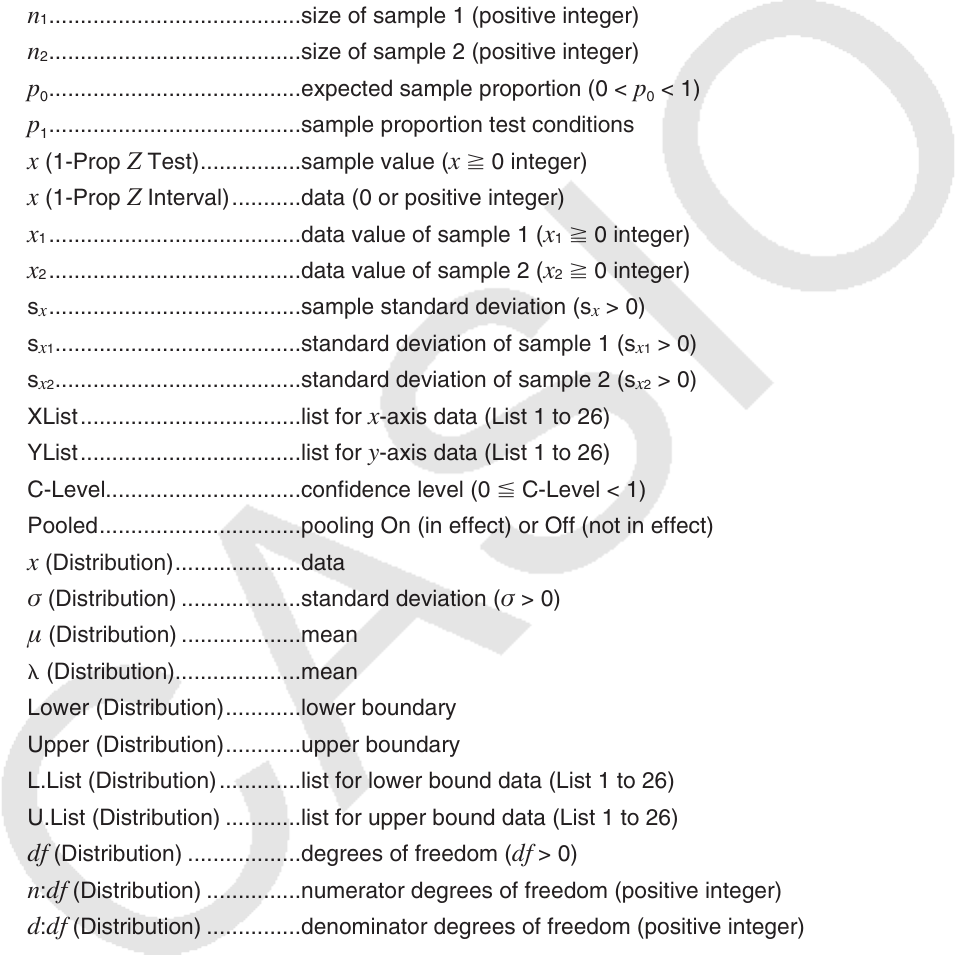User Manual
Table Of Contents
- Contents
- Getting Acquainted — Read This First!
- Chapter 1 Basic Operation
- Chapter 2 Manual Calculations
- 1. Basic Calculations
- 2. Special Functions
- 3. Specifying the Angle Unit and Display Format
- 4. Function Calculations
- 5. Numerical Calculations
- 6. Complex Number Calculations
- 7. Binary, Octal, Decimal, and Hexadecimal Calculations with Integers
- 8. Matrix Calculations
- 9. Vector Calculations
- 10. Metric Conversion Calculations
- Chapter 3 List Function
- Chapter 4 Equation Calculations
- Chapter 5 Graphing
- 1. Sample Graphs
- 2. Controlling What Appears on a Graph Screen
- 3. Drawing a Graph
- 4. Saving and Recalling Graph Screen Contents
- 5. Drawing Two Graphs on the Same Screen
- 6. Manual Graphing
- 7. Using Tables
- 8. Modifying a Graph
- 9. Dynamic Graphing
- 10. Graphing a Recursion Formula
- 11. Graphing a Conic Section
- 12. Drawing Dots, Lines, and Text on the Graph Screen (Sketch)
- 13. Function Analysis
- Chapter 6 Statistical Graphs and Calculations
- 1. Before Performing Statistical Calculations
- 2. Calculating and Graphing Single-Variable Statistical Data
- 3. Calculating and Graphing Paired-Variable Statistical Data (Curve Fitting)
- 4. Performing Statistical Calculations
- 5. Tests
- 6. Confidence Interval
- 7. Distribution
- 8. Input and Output Terms of Tests, Confidence Interval, and Distribution
- 9. Statistic Formula
- Chapter 7 Financial Calculation
- Chapter 8 Programming
- Chapter 9 Spreadsheet
- Chapter 10 eActivity
- Chapter 11 Memory Manager
- Chapter 12 System Manager
- Chapter 13 Data Communication
- Chapter 14 Geometry
- Chapter 15 Picture Plot
- Chapter 16 3D Graph Function
- Appendix
- Examination Mode
- E-CON4 Application (English)
- 1. E-CON4 Mode Overview
- 2. Sampling Screen
- 3. Auto Sensor Detection (CLAB Only)
- 4. Selecting a Sensor
- 5. Configuring the Sampling Setup
- 6. Performing Auto Sensor Calibration and Zero Adjustment
- 7. Using a Custom Probe
- 8. Using Setup Memory
- 9. Starting a Sampling Operation
- 10. Using Sample Data Memory
- 11. Using the Graph Analysis Tools to Graph Data
- 12. Graph Analysis Tool Graph Screen Operations
- 13. Calling E-CON4 Functions from an eActivity

6-67
Freq....................................frequency (1 or List 1 to 26)
Freq1..................................frequency of sample 1 (1 or List 1 to 26)
Freq2..................................frequency of sample 2 (1 or List 1 to 26)
Execute ..............................executes a calculation or draws a graph
o .........................................mean of sample
o
1
.......................................mean of sample 1
o
2
........................................mean of sample 2
n .........................................size of sample (positive integer)
n
1
........................................size of sample 1 (positive integer)
n
2
........................................size of sample 2 (positive integer)
p
0
........................................expected sample proportion (0 < p
0
< 1)
p
1
........................................sample proportion test conditions
x (1-Prop Z Test) ................sample value ( x 0 integer)
x (1-Prop Z Interval) ...........data (0 or positive integer)
x
1
........................................data value of sample 1 ( x
1
0 integer)
x
2
........................................data value of sample 2 ( x
2
0 integer)
s
x
........................................sample standard deviation (s
x
> 0)
s
x
1
.......................................standard deviation of sample 1 (s
x
1
> 0)
s
x
2
.......................................standard deviation of sample 2 (s
x
2
> 0)
XList ...................................list for
x -axis data (List 1 to 26)
YList ...................................list for
y -axis data (List 1 to 26)
C-Level...............................confidence level (0 C-Level < 1)
Pooled ................................pooling On (in effect) or Off (not in effect)
x (Distribution) ....................data
(Distribution) ...................standard deviation ( > 0)
(Distribution) ...................mean
(Distribution)....................mean
Lower (Distribution) ............lower boundary
Upper (Distribution) ............upper boundary
L.List (Distribution) .............list for lower bound data (List 1 to 26)
U.List (Distribution) ............list for upper bound data (List 1 to 26)
d f (Distribution) ..................degrees of freedom ( df > 0)
n : df (Distribution) ...............numerator degrees of freedom (positive integer)
d : df (Distribution) ...............denominator degrees of freedom (positive integer)
Numtrial (Distribution) ........number of trials
p (Distribution) ...................success probability (0 p 1)










